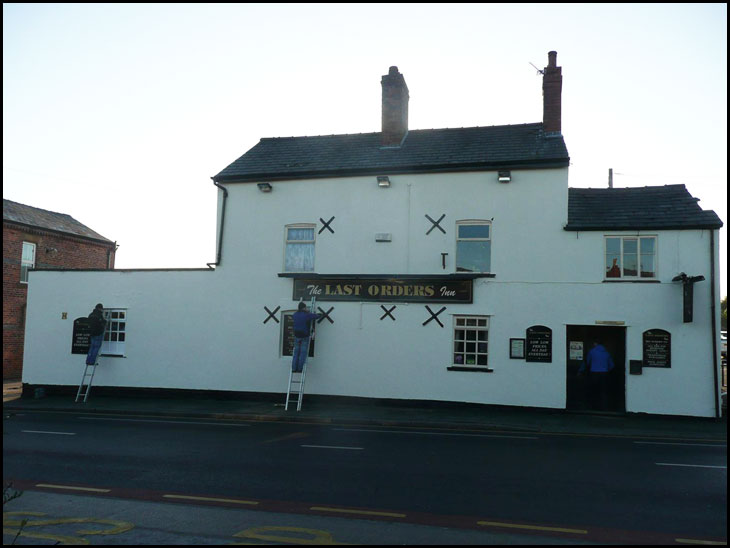Photo-a-Day (Tuesday, 8th January, 2013)
Last Orders

Photo: Alan Banks (Panasonic DMC-TZ3)
What a lovely looking pub Alan.....
Looks like they are keeping on top of the painting......Happy New Year to you.....cheers!!!
There`s a photo, No.21524 in Album, Places, Standish (Page 5, 1st on bottom row). This shows `The White Duck` and states that this pub has had a no.of names inc.`The Bear`s Paw` and `The Standish Arms.`
Issue No. 21 of `Past Forward` has an article on 1st page `News from The Archives`. This lists the pubs in Standish owned by J B Almond, Standish. There were 8 of them - see
http://www.wlct.org/heritage-services/pf21.pdf
Photo would have been better if the sky was blue with cumulus clouds, Alan !!
I remember it as the White Duck.
Why the black crosses |?
They used to call it the Mucky Duck.
At one time they changed the name to the Bears Paw I cant think why.
The crosses are the ends of ties which pass through the building to hold it up, Alan. Many buildings in mining areas are held up against the forces of subsidence.
I was on a bus in Earlestown on Saturday, beside the town hall. As we awaited its departure I had time to look closely at a set of windows in front of me. The longer I looked the more amazed I was that the building was still standing - the brickwork around the windows was at all sorts of angles, and then I noticed plates on the ends of ties through the building, and then ties which were around the outside of the walls from end to end, binding them together.
Alan I think you will find the ' black crosses' are called ties, they basically hold the building together by passing metal rods through the building from one side to the other to stabilise it.
Alan the black crosses are probably strengthening rods.If there was any sign of the building moving(subsidence) then they would pass large metal rods through the structure and put large cross pieces on each end and then tighten them with large bolts to help hold the structure together.
Alan I think it has something to do with rods that go through the building to hold it together (subsidence) or may be it is nothing like that......decor....maybe. Cheers!!!
That was a game my sisters and I used to play on the way to Southport.....count how many houses had bands on them each side of the road just to give us something to do....cheers!!!
The cross is the tie-plate which screws on to both ends of the tie-rod which is threaded at both ends.they are then tightened with a big spanner. They come in different shapes and sizes.
Alan (on Van Isle), you are obviously not into old buildings. Due to the posting system on P-a-D you`ve got 5 replies to your question! I held back knowing that someone would answer!
Rev David, St.Catharine`s steeple is well advanced: saw it from a train last Thursday.
what a boring photo
If you are familiar with the Fred Dibnah material made for television, one episode shows Fred and his companions fitting such a tie, with decorative tie plate, to his own home.
I remember it being called the FLYING BOTTLE
The nuts were tightened,then rags would be wrapped around the rods and lit,as the rods were heated the rods would expand and the nuts tightened again until the required tension was obtained.Clever us Wiganers?
The purpose of the crosses are to distribute compressive forces over 'large' areas of brickwork. Note that the arms of the crosses are 'diagonal' to spread load over several courses of brickwork. If the arms were vertical and horizontal undue load might be placed on a single course of brickwork.
My thanks to those who educated me on how to hold up a subsiding building. Very interesting.
Vancouver Island is in an earthquake zone (we had a small one yesterday),and I wonder if ties would help us here ?
Neil, there are `S` types too - extract from "Yahoo! Answers" :-
Question.
Why is there iron "s" on some of the old buildings where i live?
I live in West Sussex near Petersfield and on some of the old buildings there are some metal "s" on the walls. Are they structural or are they just an old design?
Answer
They're structural. If you look closely you'll see a big nut in the centre. There's a long bar running though the building to hold the walls together, threaded at the ends with nuts fitted over the "S" shapes which are designed to spread the load more widely over the wall.
Found the link for film of Mr Dibnah fitting tie rods:
http://www.youtube.com/watch?v=hvQnr2GrozU
STANDISH DRINKER, IT HAS NEVER BEEN CALLED ''THE FLYING BOTTLE'' UNOFFICIALLY YES, BY THE NE'ER DO WELLS THAT FREQUENT IT. IT,S HAD FOUR NAMES IN THE 70 YEARS THAT I HAVE KNOWN IT, AND THAT WASN,T ONE OF THEM.
I am sure The White Duck was run by Bert LLewellyn who played fert latics. He took it on when he stoppped playing. He was a great number 8, complementing the great Harry Lyon